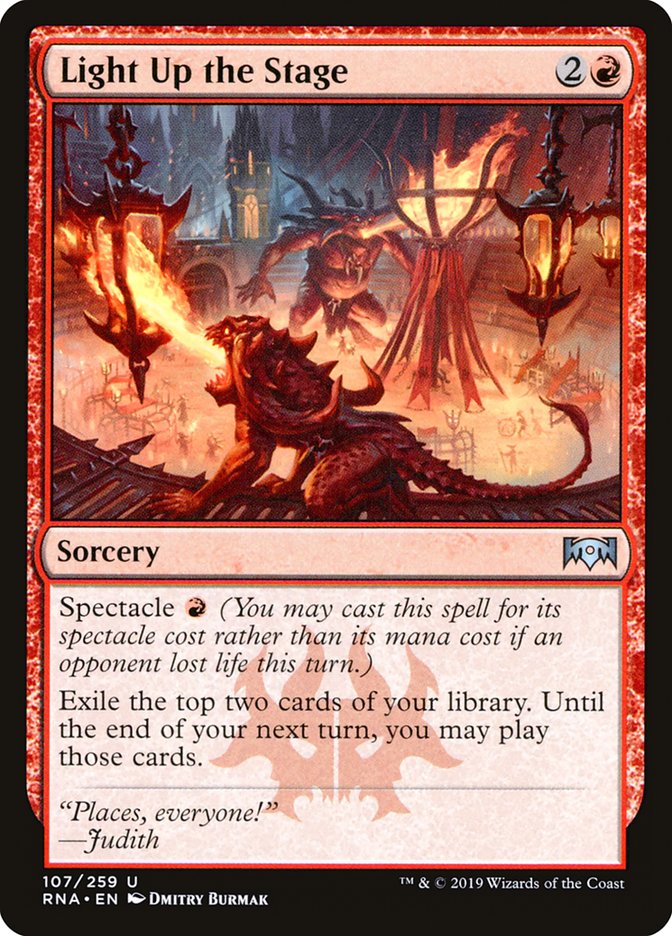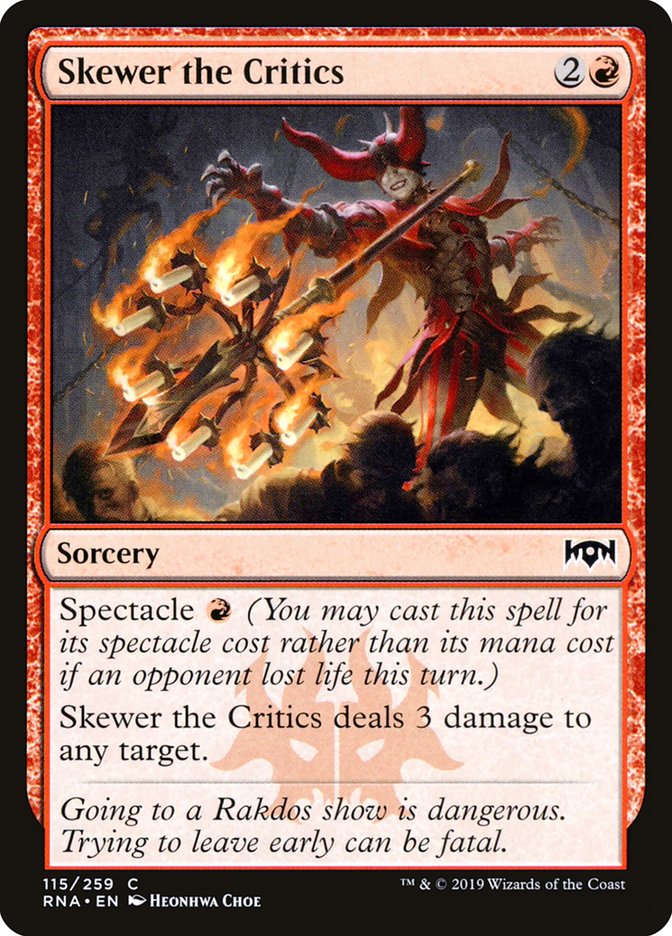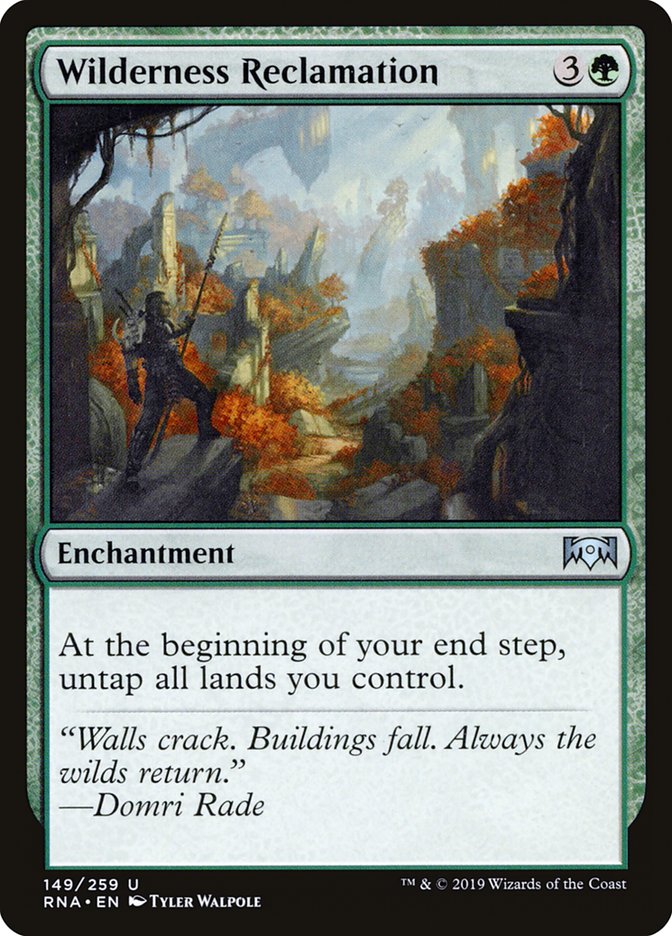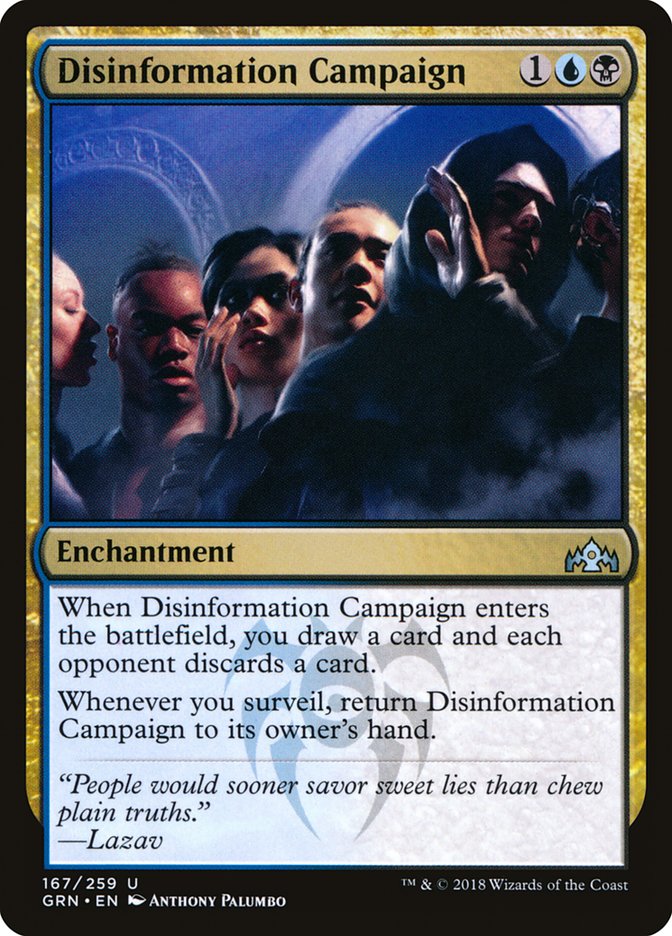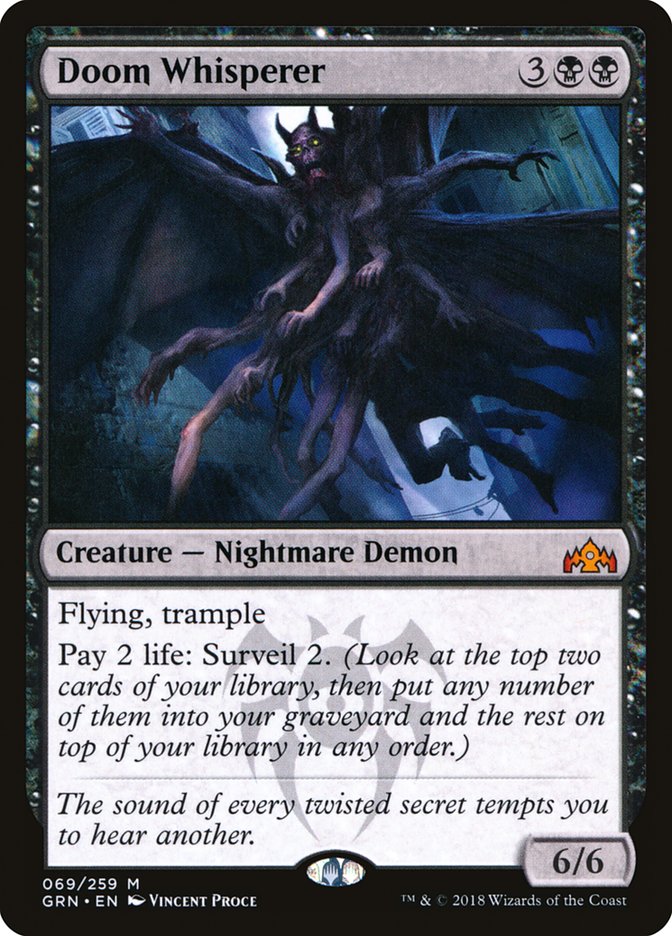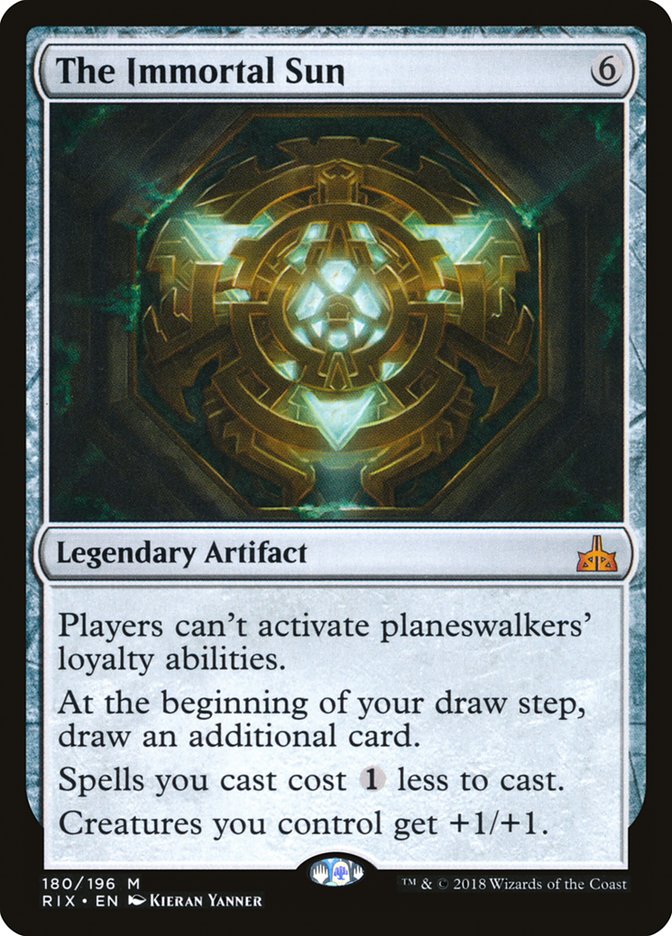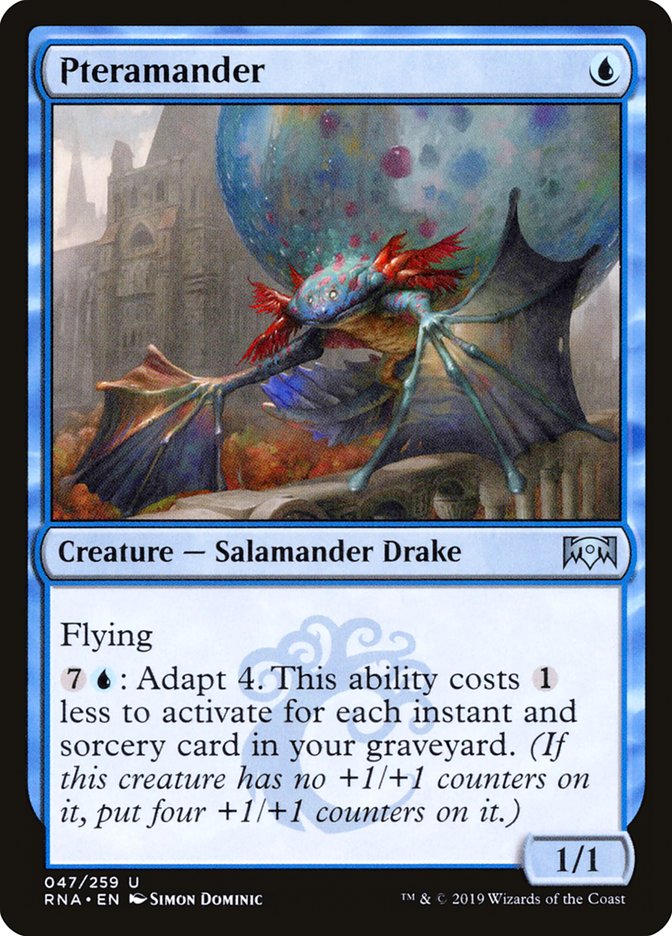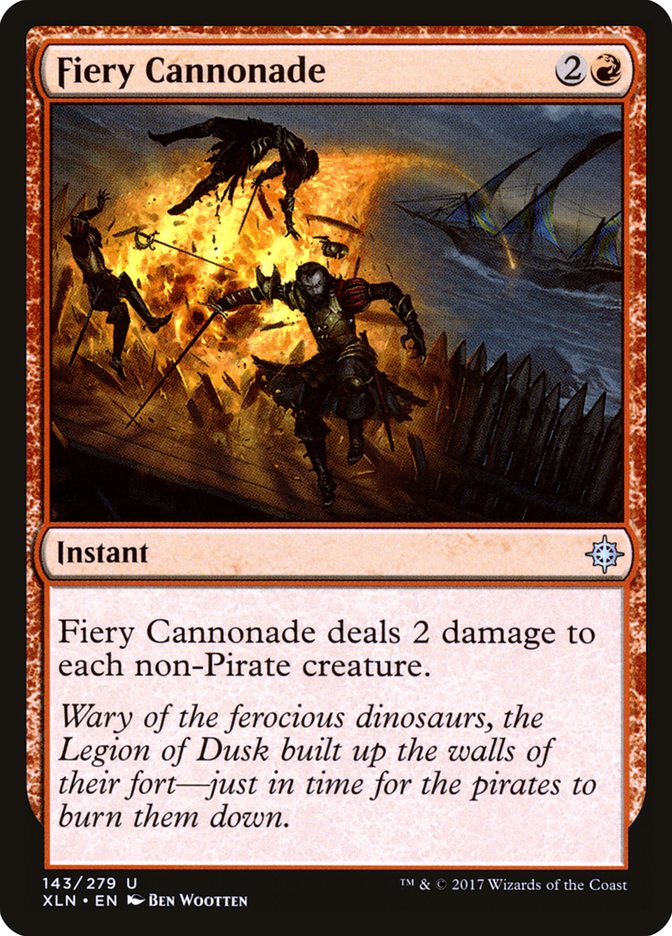It’s funny how fast Standard can change. One weekend it can feel as though you can do no wrong, but the next all your good matchups disappear, and you feel like you are lost at sea. That’s been my experience thus far in Ravnica Allegiance Standard. Today I’m going to talk about the changes I’ve made to my Esper Midrange strategy, why I abandoned it, and how I’ve decided to attack the metagame for Grand Prix Memphis.
When looking at why Esper Midrange has deteriorated in viability, all it takes is a couple of moments to step back and look at the evolution of the format. Before any tournaments had occurred, there seemed to be two main boogeymen looming. Mono-Red, a playable if unexciting aggro deck, had gained the unusually efficient tools of Light up the Stage and Skewer the Critics. Meanwhile the resident combo deck of late featuring Nexus of Fate had gotten Wilderness Reclamation, a turbocharged source of mana that harkens back to the days of Urza block.
Both decks flopped Week 1 at SCG Indianapolis as Sultai Midrange and Esper Control came prepared, and this led to results at SCG Baltimore that I had a difficult time processing. A whopping four copies of Esper Control had made it to the elimination rounds. While I had heard rumblings from friends that the deck was “broken” and “had no bad matchups,” they’re prone to hyperbole, so I hadn’t invested as much time as I should’ve with the strategy.
It was at this point I decided I couldn’t continue playing Esper Midrange without some changes. While Sultai and traditional Esper were winnable matchups, they aren’t the matchups you want to play. The combination of sweepers and repeatable card advantage of Teferi or Krasis chains overpowered your more incremental forms of advantage, and it seemed that Thought Erasure and Thief of Sanity had to show up in large numbers to have success. Tweaks had to be made, and with a format based around attrition in mind, I came to this list.
Creatures (19)
- 2 Hostage Taker
- 2 Doom Whisperer
- 4 Thief of Sanity
- 3 Deputy of Detention
- 4 Basilica Bell-Haunt
- 4 Hero of Precinct One
Lands (24)
Spells (17)
Sideboard

The Angel package was gone. In its place I instead leaned into the inherent surveil synergies to play Disinformation Campaign. Esper Control in particular is soft to this repeatable source of discard, as a deck with limited forms of countermagic. Campaign can be used in conjunction with Basilica Bell-Haunt to strip away removal before deploying your premium threats like Thief of Sanity. Doom Whisperer was added to increase the potency of the enchantment, and while the extra maindeck lifegain of Lyra was missed, the large flying creatures seemed very similar in impact upon hitting the field.
The final new inclusion that I’d like to talk about is The Immortal Sun. Many times people have asked me if Teferi should be included in this list, and after playing with the Sun, I’m confident in saying it’s the source of card advantage you really want. Beyond the extra card each turn, it provides what might be the only Anthem effect playable in the shell, thus greatly increasing the potency of the tokens Hero of Precinct One produces and boosting the Bell-Haunt out of Finality range. Esper Midrange doesn’t have the highest density of answers to planeswalkers, so having two additional ways to shut down opposing Viviens or Teferis does wonders to increase your win percentage against Sultai and traditional Esper.
By watching the format develop and evolve, I’m close to locking in what may be a surprising strategy for GP Memphis this weekend – Izzet Drakes. It’s a particularly unusual choice for me, as it’s a deck that I wasn’t fond of last season. Many games were lost as a result of one too many turns of wheel-spinning and it often felt like something was missing from the strategy, but I could never quite place it. Thankfully Ravnica Allegiance graciously gifted us Pteramander and the innocuous one-drop has done wonders to tie the room together.
The largest element that the newest Drake adds is unlocking extra power from many cards you already wanted to play. Against decks that are looking to trade one-for-one with your low number of threats, sneaking in an early draw-two with Chart a Course before their interaction comes online is a huge boon. Pteramander is also excellent with the one-mana protective spells by virtue of being so cheap to play, and because of adapt, your copies of Dive Down and Spell Pierce become live earlier in the game. This decreases the amount of awkward or dead cards that sit in your hand.
While Izzet Drakes isn’t the most customizable archetype, this is the list I’ve been playing while constantly staying in the Top 10 of the ranked Arena ladder.
Creatures (12)
Lands (21)
Spells (27)

The one unusual maindeck card that I’ve been having great success with is Negate. To see why, simply look at the top three archetypes from SCG Dallas. Esper Control, Mono-Blue Aggro, and Sultai Midrange all have a wealth of high-impact targets at almost all points in the game. Negate is excellent against less common strategies such as Four-Color Gates, being one of the few ways to save your team against Gates Ablaze. The only popular Standard deck that makes the two-mana counterspell look less than stellar is Azorius Aggro, but even there you have the ability to hit relevant targets like History of Benalia and Conclave Tribunal.
The main draw to the strategy is a highly positive matchup against the breakout deck of last weekend, Mono-Blue Aggro. Many decks have some amount of cheap interaction and other decks can play high-impact flying creatures that brick-wall the cheap threats out of Mono-Blue, but Izzet Drakes can do both. Pteramander is surprisingly effective here as well, serving as a threat that sneaks in under countermagic that can adapt to dominate the battlefield. If Mono-Blue continues to be a top archetype in Standard, Izzet Drakes will be my go-to choice to exploit that.
Izzet Drakes also shares one of the primary strengths that has helped Mono-Blue during the deck’s rise to prominence – the ability to punish clunky removal with Spell Pierce and Dive Down. While you’re not a huge favorite against Sultai and Esper can be tough, both decks rely on mana-intensive spells to get your threats off the battlefield, leaving many games stolen by a timely protective spell.
The rise of Azorius Aggro worries me the most. Combining a quick clock with creatures that reach four power means that you have little time to find your Drakes, and even when you do, they may not be effective blockers. My last big hurdle is to find the right mix of sideboard cards to combat the matchup. Fiery Cannonade is likely the highest-impact card as a potential three-mana sweeper but has a limited window to be effective before the creatures grow too large. Raptor Hatchling may be the best supplemental answer, as it always blocks twice and frequently eats two creatures on its way out. If I can get this matchup close to even, I’ll be happy to bring the deck to Memphis.
Ravnica Allegiance Standard continues to be excellent and it rewards those who pay close attention to trends and metagame shifts. Many decks are evenly matched and nothing seems to have the staying power to remain the best deck for multiple weeks in a row. Izzet Drakes has been lurking in the shadows for a while now, and I think we’ve reached the point where it’s an excellent choice for this weekend.


